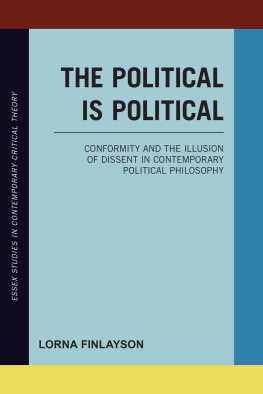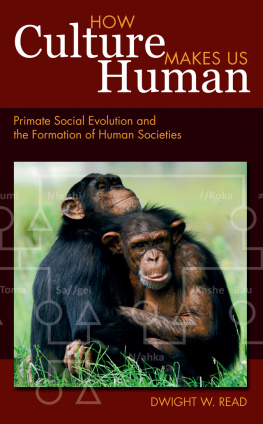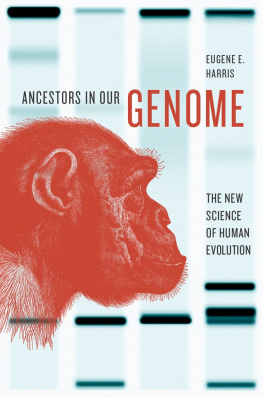THE IMPROBABLE PRIMATE
THE IMPROBABLE PRIMATE
HOW WATER SHAPED HUMAN EVOLUTION
CLIVE FINLAYSON


Great Clarendon Street, Oxford, OX2 6DP,
United Kingdom
Oxford University Press is a department of the University of Oxford.
It furthers the Universitys objective of excellence in research, scholarship, and education by publishing worldwide. Oxford is a registered trade mark of Oxford University Press in the UK and in certain other countries
Clive Finlayson 2014
The moral rights of the author have been asserted
First Edition published 2014
Impression: 1
All rights reserved. No part of this publication may be reproduced, stored in a retrieval system, or transmitted, in any form or by any means, without the prior permission in writing of Oxford University Press, or as expressly permitted by law, by licence or under terms agreed with the appropriate reprographics rights organization. Enquiries concerning reproduction outside the scope of the above should be sent to the Rights Department, Oxford University Press, at the address above
You must not circulate this work in any other form and you must impose this same condition on any acquirer
Published in the United States of America by Oxford University Press
198 Madison Avenue, New York, NY 10016, United States of America
British Library Cataloguing in Publication Data
Data available
Library of Congress Control Number: 2013948417
ISBN 9780199658794
Printed in Italy by
L.E.G.O. S.p.A.
CONTENTS
NEVER MORE THAN ONE SPECIES OF MAN
In 1950, Ernst Mayr wrote about our species and our evolution in a Cold Spring Harbor symposium which was dedicated to the origin and evolution of man.evaluation of taxonomic categories. He recognized that the arrival of the fully upright human marked a significant and unprecedented departure from anything that had come before and surmised that this arrival in what he called a different adaptive zone exposed humans to new selection pressures. This departure from all primate models that had preceded it, was so marked that it deserved a higher taxonomic category than that of species. With Homo came a new genus and, I would argue, a highly improbable primate. Mayr then went on to make a remark for which he has been criticized by palaeoanthropologists ever since. Mayr clearly stated that Indeed, all the now available evidence can be interpreted as indicating that, in spite of much geographical variation, never more than one species of man existed on the earth at any one time. Mayr, I will argue, was right even though today many scholars of our evolution would disagree, still preferring to award species status to fossils of Homo based on morphological criteria.
The possible exception to Mayrs statement could be the Hobbit on Flores. Its small stature may have prevented interbreeding with other humans, purely because of physical limitations, but we cannot be certain of this. The application of the biological species concept to allopatric populations, those separated from each other by geographical or other barriers, has always been problematic because it is impossible to know whether those populations might be capable of interbreeding were these impediments removed. The Hobbit, isolated in a remote world almost taken out of a Jules Verne novel, is an example of an allopatric population whose taxonomic status is difficult to determine. Hobbit aside, what is clear now is that Homo sapiens was a polytypic species, that is, highly geographically variable but all individuals capable of reproducing with each other as Mayr recognized, but no different from many other similar examples from the natural world. But there is no evidence to suggest that these populations were ever distinct enough for interbreeding to have been prevented. The bastion of the palaeoanthropologists who supported the many species of Man, the Neanderthals, collapsed with the clear evidence that our own lineage interbred with theirs to a sufficient degree that the signal was retained in our genome. Then came the Denisovans, another ancient lineage now also shown to have exchanged genes with our own. If these populations were able to interbreed, and behave like one and the same species, after hundreds of thousands of years of isolation, then the question is resolved and Mayr shown to have been right.
Not everyone agrees. Some palaeoanthropologists maintain a multi-species view while accepting that there was interbreeding. They argue that hybridization can occur in the wild today between closely related species. However, this is not what we observe with the Neanderthals, the Denisovans, and our ancestors. If the genetic signal has been retained right down to today, interbreeding would not have been an isolated affair.
Some notable palaeoanthropologists have followed Mayr in declaring Homo sapiens to have been a polytypic species throughout its nearly 2-million-year-old history. Emiliano Aguirre, the great scientist who discovered the spectacular site of Atapuerca was one and Milford Wolpoff in Michigan was another.others, like Homo erectus and Homo heidelbergensis. Linked to these distinctions was the Out-of-Africa model. It explained the global expansion of our species from the African continent in relatively recent times, perhaps no more than 50 thousand years ago; our ancestors replaced all the archaic Homo species that they came across during the epic journey. It really was about how superior we were and how we had left no room for anyone else on the planet. We just had to be a different species.
How wrong we were. Time has shown that Mayr, Aguirre, and Wolpoff were probably right. The criticism that will be levelled against this viewpoint is that it is clear that the evolution of Homo was not linear and species branched off repeatedly. Lineages certainly branched off repeatedly, many more times than even the most ardent species-splitting palaeoanthropologist might admit; but they were lineages, not species. It may be argued that palaeoanthropologists are using the definition of species in a different way, following concepts of palaeontological species for example.of small samples and the discontinuity of the fossil record and mask continuous evolutionary trajectories over 2 million years. If the end products, after those 2 million years, were still behaving as one and the same species then it is unlikely that earlier forms, which were separated by less time, would have been any different.
In the early days I was taken by the multi-species idea and also by the Out-of-Africa replacement model. It seemed clear-cut and beyond dispute. But as I started to read more papers and books, and to think about all that I had been taught as a zoologist about the biogeography and evolution of species I began to question the widely accepted model. I was then only getting started in the world of human evolutionary studies and the views of a newcomer, and one who was not even a palaeoanthropologist, cut no ice. But the field of human evolution is first and foremost biology; the field of human geographical dispersals and extinctions is biogeography; and the field of the dynamics of human populations is population genetics. So lets use these tried and tested tools to understand ourselves. We might do better than developing hypotheses on the basis of metric measurements of isolated human crania when we cannot get a handle on the natural variation within the populations from which the crania came.
Next page












